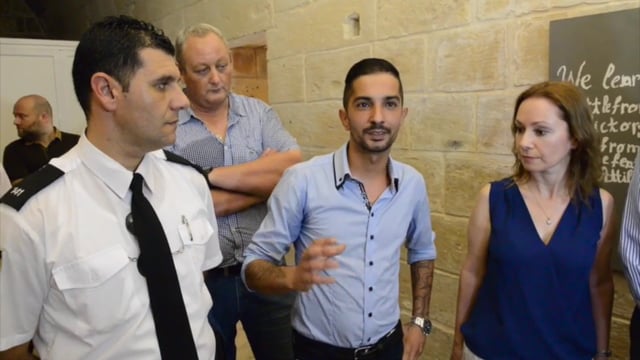[WATCH] Inmates set up UnLock art exhibition as part of VIVA 2015
Home Affairs Minister Carmelo Abela launches ‘UnLock’ art exhibition, set up by inmates at Corradino Correctional Facility.




Home affairs minister Carmelo Abela launched an art exhibition set up as part of the Valletta international Visual Arts festival earlier today.
The exhibition features installations prepared by 12 inmates from the Corradino Correctional Facility.
Project coordinator Pierre Mifsud said that the installation had given inmates the liberty to unleash their creativity and express themselves, and that many had chosen to tell their story through their art work. He added that some of the inmates had previous experience of art, but that many had discovered a new skill in the project.
"On our part, we only gave them the idea of the project but the art pieces were all their own creations," he said, stressing that at the beginning of the project he had no idea where the projects would take them.
Inmate Eman Cassar explained that the installation was highly symbolic.
"The grey box which contains the twelve scenes, one per artist, is painted grey to represent the monotonousness that many people associate with prison," he said.
Cassar added that the box had twelve openings shaped like keyholes through which people could view the individual art pieces, and that the openings placed at different levels of the box, represented the ups and downs of life in prison.

“When we first started working on this project, we had all thought the project wouldn’t amount to much, but eventually, the project gave us a sense of worth and it gave us an opportunity to give something to the outside world,” Cassar said.
He further explained that the project had also given them the opportunity to work together and to support each other in learning new skills.
“This project helped us to become like a family, while at the same time allowing us to express our individuality,” Cassar noted.
Another area of the exhibition presented various keys of different sizes and at different heights hanging from the ceiling.
“The keys represent the various aspirations and ambitions that inmates might have, and they are a reminder that just like the key has locked them up, so too will a key be the thing that liberates them,” Mifsud said.

He added that the keys at different heights represented the fact that some aspirations were slightly more distant than others, but the central key, which is white is a representation of hope.
Mifsud also explained that the main themes chosen by the inmates were issues like frustration, dilemmas, and the struggle of choosing between good and bad. He further explained that the location of the exhibition had also been particularly symbolic, given that the school had also served as a Court at one point in history.
Speaking at the event, Abela said that the themes expressed by the art works were relevant both to the inmates themselves, but also to those outside.
“Those people who recognize the themes and who can relate them to their own lives, are forming part of a dialogue with these inmates,” Abela said.
Abela further explained that the ministry was also working hard to promote learning and allow inmates to have a second chance at life with new skills and opportunities.
Referring to a quote written on a plaque by one of the inmates, Abela also stressed that it wasn’t just up to the facility to give inmates a second chance at life, but society also needs to work to provide them with an opportunity to start over again.

“Participation in these projects shows that the inmates have a desire to move forward from the mistakes they made in the past,” Abela added.
Abela urged inmates to come forward and participate in projects like these, and he added that the facility was organizing as many varied classes and projects as possible.








.jpg)




.jpg)






.png)


